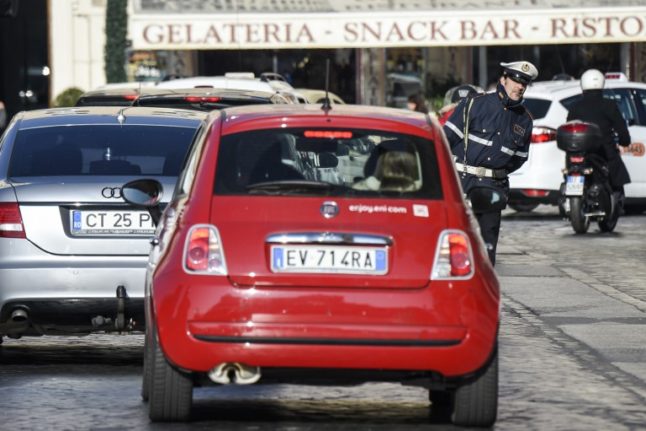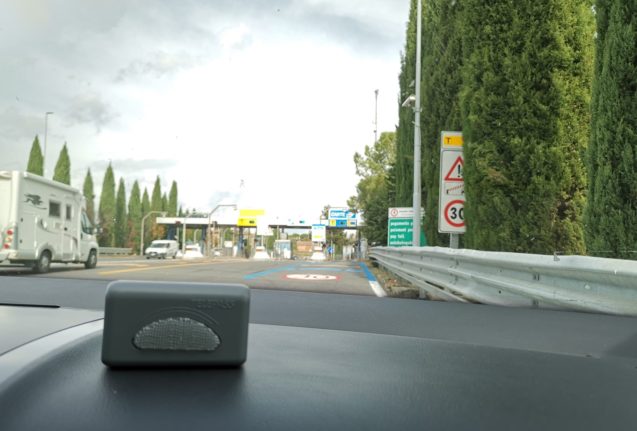When the Italian government passed a package of law-and-order reforms last month, most of the spotlight was on changes that make it harder for asylum seekers and refugees to find protection in Italy.
But the so-called security decree, the brainchild of Interior Minister Matteo Salvini, also has consequences for less vulnerable foreigners in Italy.
FOR MEMBERS: What Italy's new laws mean for your citizenship application
The Local has already looked at how the new laws affect people applying for Italian citizenship via ancestry or marriage.
Here we'll look into another aspect of the decree that's a potential headache for international residents: changes to the rules about driving a foreign vehicle in Italy.
What's changed?
The new law cracks down on vehicles registered abroad being driven in Italy.
Until now cars with foreign licence plates were allowed to be on the road for up to one year, provided they weren't in the country for more than six months out of 12. But a new clause in the Highway Code now states:
“It is forbidden for anyone who has resided in Italy for more than 60 days to drive a vehicle registered abroad.”
In other words, if you bring your car to Italy with you when you move, you now have just two months (starting from the time you declare residency) to get it registered here.
Who do the rules apply to?
Everyone, whether you're a foreign national or an Italian citizen. As well as targeting foreigners who haven't got their paperwork in order, another aim is to crack down on Italians who drive cars registered abroad in order to avoid paying tax, save on insurance bills or escape fines for bad driving.
The same rules apply whether the vehicle is registered in another EU country or further afield: unless the plates are Italian, they need to be swapped.

Photo: DepositPhotos
What if I drive a company car?
The new rules make an exception for vehicles loaned or leased from companies outside Italy but within the European Economic Area (EU countries plus Iceland, Liechtenstein and Norway).
In that case, you'll need to carry documents with you to certify who the car belongs to and how long you're authorized to use it for. If you're found driving without paperwork, you're liable to be fined between €250 to €1,000 and asked to produce the documents required within 30 days.
What happens if I don't do anything?
Any resident found driving a foreign-registered car illegally faces a fine of anywhere between €712 and €2,848. You'll be ordered to keep your vehicle off the road, and if you don't begin the process of registering it in Italy within 180 days, the authorities can seize it from you.
Don't believe they'll really do anything? Since the laws came into effect in December, the first stops have already been made: police in Milan last week flagged down and fined the driver of a Romanian-registered vehicle, the Corriere della Sera reports.
So what should I do?
If you'll be driving in Italy long term, you'll need to register your vehicle with both the Motorizzazione Civile (Motor Vehicles Office) and the Pubblico Registro Automobilistico (Public Vehicle Registry).
Only legal residents can do so, so first get your permesso di soggiorno (residence permit) or, if you're an EU citizen, your certificato di residenza (proof of residence). You'll also need your codice fiscale (personal tax code).
FOR MEMBERS: How to beat (or just survive) bureaucracy in Italy: the essential pieces of Italian paperwork

Photo: DepositPhotos
The next step is to inform the licensing authority in your home country that you'll no longer be using your car there. You'll have to show the Italian authorities official proof of (de)registration, as well as proof that you own the car.
Then you'll need to prove that your vehicle is suitable to be driven in Italy. Ask the manufacturer or a licensed dealer for an official description of its technical specifications, then take it to a mechanic for a roadworthiness test. If it meets Italian road standards, you'll be issued a certificate of conformity.
Take all those documents – translated into Italian – to your local Motorizzazione Civile office. If everything's in order they'll issue you Italian licence plates and a carta di circolazione (registration certificate), which you should carry with you at all times. Then within 60 days you need to enter your vehicle into the public registry, maintained by the Automobile Club d'Italia (ACI).
Or, if you're importing your car from an EU country, you can use the ACI's handy Sportelli Telematici dell'Automobilista (STA) service, a one-stop shop for registering your vehicle and obtaining Italian licence plates.
For more information about how to register an imported vehicle and what fees you can expect to pay, see the ACI's guidelines (in Italian).
READ ALSO: What you need to know about Italy's new petrol pump labels

Photo: Andreas Solaro/AFP
Sound like a lot of work to hold on to your beat-up Fiesta? The new rules might make you decide it's simpler to buy a car in Italy instead, where a dealer can help walk you through the paperwork.
Either way, once you're registered you'll need to pay the compulsory road tax (bollo) and arrange car insurance (assicurazione auto) that includes third-party liability (responsabilità civile). And once your car's more than four years old, be prepared to visit a mechanic every two years for a mandatory road worthiness test (revisione).
Do I need a new driving licence too?
No. The new rules don't affect who can drive in Italy, only what they drive.
The existing requirements still apply, namely: an EU driving licence allows you to drive in any member state. If you got your licence elsewhere in the world, you either need to provide an official translation or get an International Driving Permit (valid for one year, it's essentially a recognized translation of your permit into multiple languages). And if you're a non-EU national living in Italy, you'll need to convert your licence to an Italian one within one year of moving there.
FOR MEMBERS: 'Expect the unexpected': What you need to know about driving in Italy

Photo: DepositPhotos



 Please whitelist us to continue reading.
Please whitelist us to continue reading.